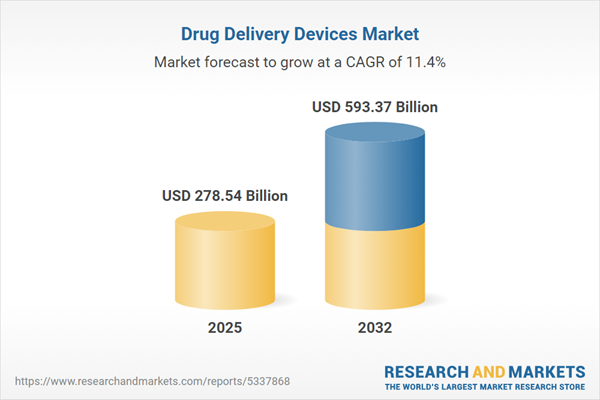Speak directly to the analyst to clarify any post sales queries you may have.
The drug delivery devices market is undergoing significant transformation, driven by digital innovation, changing regulatory requirements, and rising patient expectations. Senior executives must rapidly navigate these shifts, adopting forward-thinking strategies to maintain operational strength and capitalize on emerging opportunities.
Market Snapshot: Drug Delivery Devices Market Growth and Outlook
The global drug delivery devices market is valued at USD 250.23 billion, with projections indicating growth to USD 278.54 billion by 2025 and an anticipated reach of USD 593.37 billion by 2032. This expansion—at a compound annual growth rate of 11.39%—is being shaped by the integration of sophisticated delivery technologies and evolving regulatory frameworks. Heightened patient focus continues to boost innovation as sector players expand collaboration. The adoption of digital health solutions is increasing workflow efficiency and accessibility, while healthcare providers adapt quickly to new needs. Major manufacturers are aligning investments with sector trends, enabling effective responses to operational and clinical demands across international markets.
Scope & Segmentation of the Drug Delivery Devices Market
This report offers senior leaders a detailed analysis to inform high-impact investment and operational choices. The segmentation framework ensures market clarity, addressing the most relevant product categories, technology trends, and geographic variations. Key market segments include:
- Delivery Modalities and Mechanisms: Evaluation of applications in both biologics and small molecules, with insights into durability, advanced safety features, and the adoption of sustainable materials such as high-performance polymers and specialized glass.
- Auto-Injectors and Inhalers: Coverage of emergency and chronic-use settings, with a focus on ergonomic improvements and innovative device designs supporting care in home and clinical environments.
- Pen Injectors and Insulin Pumps: Analysis of disposable and reusable solutions, as well as advances in patient-centric delivery through wearable patches and implantable devices.
- Nebulizers and Patches: Discussion of technology evolution from traditional jet and ultrasonic models to next-generation mesh nebulizers and microneedle patches aimed at improving flexibility and comfort.
- Jet Injectors: Review of needle-free systems—including mechanical and spring-driven models—with emphasis on safety enhancements and their role in diverse care settings.
- Geographic Regions: Highlights of market trends across the Americas, Asia-Pacific, and EMEA, with special attention to advancements and ecosystem dynamics in China, India, Japan, and Australia that are transforming supply chains and device development.
- Strategic Technologies: Examination of new polymer chemistries, scalable 3D-printing capabilities, integration of advanced sensors, and blockchain applications for traceability from production to delivery.
- Leading Companies: Profiles of industry leaders, including strategies from Becton, Dickinson and Company; West Pharmaceutical Services; Medtronic plc; and Insulet Corporation, with discussion of competitive approaches and market positioning.
Key Takeaways
- Smart sensor integration is increasing patient engagement and supporting precise, data-driven clinical interventions across a range of devices and treatment pathways.
- Connected digital health ecosystems are facilitating seamless cooperation between manufacturers and healthcare providers, resulting in optimized production and improved resource allocation.
- Distributed manufacturing strategies and diverse sourcing models are reinforcing supply chain resilience, providing protection against unexpected regulatory or economic changes.
- Broadening of product portfolios enables providers to respond promptly to evolving clinical requirements and changing patient care preferences.
- Industrywide partnerships and collaborative efforts are fostering digital transformation and helping organizations stay aligned with regulatory developments.
- End-to-end digital solutions are supporting responsive adaptation to ongoing sector changes, positioning companies for long-term success while enhancing service delivery.
Tariff Impact: Supply Chain Adaptation
With anticipated shifts in U.S. tariff policies, drug delivery device manufacturers are strengthening supplier relationships, broadening distribution, and implementing focused cost-management measures to address evolving regulatory and economic demands.
Methodology & Data Sources
This report is based on executive interviews, end-user surveys, and careful reviews of regulatory and patent documentation. SWOT and PESTEL analyses underpin the assessment of market dynamics, ensuring solid, actionable insights for senior decision-makers.
Why This Drug Delivery Devices Market Report Matters
- Provides the intelligence needed for informed material selection, accelerated systems integration, and full regulatory compliance throughout the product lifecycle.
- Supports executive leadership in developing resilient supply chain strategies and minimizing exposure to regulatory and global supply disruptions.
- Supports identification and action on new opportunities for partnership and technology adoption in the context of patient-focused healthcare delivery.
Conclusion
This focused report equips senior executives with actionable market intelligence to steer strategic investments, drive operational excellence, and sustain competitiveness as the landscape for drug delivery devices continues to evolve.
Additional Product Information:
- Purchase of this report includes 1 year online access with quarterly updates.
- This report can be updated on request. Please contact our Customer Experience team using the Ask a Question widget on our website.
Table of Contents
3. Executive Summary
4. Market Overview
7. Cumulative Impact of Artificial Intelligence 2025
List of Figures
Companies Mentioned
The companies profiled in this Drug Delivery Devices market report include:- Becton, Dickinson and Company
- West Pharmaceutical Services, Inc.
- Baxter International Inc.
- B. Braun Melsungen AG
- Gerresheimer AG
- Fresenius Kabi AG
- Medtronic PLC
- Insulet Corporation
- SHL Medical AG
- Tandem Diabetes Care, Inc.
Table Information
| Report Attribute | Details |
|---|---|
| No. of Pages | 190 |
| Published | November 2025 |
| Forecast Period | 2025 - 2032 |
| Estimated Market Value ( USD | $ 278.54 Billion |
| Forecasted Market Value ( USD | $ 593.37 Billion |
| Compound Annual Growth Rate | 11.3% |
| Regions Covered | Global |
| No. of Companies Mentioned | 11 |









